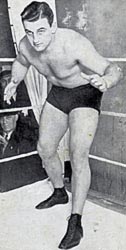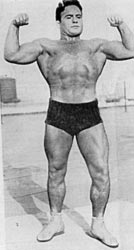
For a very small country we are proud of the fact that no fewer than ten World's heavyweight Wrestling Champions have paid us a visit (I wrote this
story in 1973 so it does not include the more recent Champions like Rick Flair, Harley Race, Jack Brisco and Giant Baba).
At the turn of the century, the great George Hackenschmidt, who appeared before thousands all over the world from Stockholm to Sydney, toured New Zealand. His matches here on an average, lasted about two minutes. Hack would then give exhibitions of strength and a display of wrestling holds. His match with the great Maori wrestler Moana Paratene, then New Zealand champion, lasted half a minute.

Stanislaus Zbyzsko first reached New Zealand while he was enroute to Lahore to meet the great Indian, Gama, who defeated him in jig time in one of history's most discussed encounters. "Zibby" arrived with his manager, Amil Klank, and an American wrestler, Frank Judson. He had only one night in New Zealand, June the 22d 1926. The New Zealand Heavyweight Champion at that time was the enormous Maori giant Ike Robin, from Hawkes Bay. Over one thousand people were unable to gain admittance to the Auckland Town Hall on the great night. The immense strength of the Maori was a revelation to Zbyszko, and try as he did, bringing into play all his ringcraft and cunning, he could not pin the New Zealander's shoulders to the mat. After the bout, which the former World's champ won on points after there had been no falls, Zbyszko said that Robin's strength was enormous. (Although the Auckland bouts were billed as World Title bouts Zibby was in fact not the Champion when he came here).

On his return visit to Auckland, the same year, Zbyszko tangled with Robin on two more occasions. The first was a draw with one fall each, held before another sell-out crowd. Fifteen days later, in the same ring, a third bout drew yet another sell-out crowd and once again the confident Robin made most of the action. The only fall of the match was obtained by Zbyszko in the seventh round, when he was able to take advantage of Robin missing an attempt to throw him.
Joe Stecher came to New Zealand in 1930 with his brother Tony. He appeared in only the one contest out here against "Hangman" Howard Cantonwine at Wellington, but Tony stayed on for a longer campaign.


Gus "The Goat" Sonnenberg arrived in New Zealand in 1934, and caused quite a stir with his fantastic flying tackle. The fans wanted thrills and Sonnenberg was the boy to provide them. He struck some pretty tough opposition out here too. Dr. Freddie Meyer, Rene Michot, Harry Mamos, Oki Shikina, Dan Koloff, Wong Buck Cheung, Dean Detton, Ali Bey, George Walker, Anton Koolinan, and John Keatos, a pretty fearsome line-up of top talent.

When the handsome and talented Ed Don George, one of the University of Michigan's sports immortals, arrived here in the latter months of the 1936 season, the publicity drums began to roll, for it was obvious that Earl McCready versus Ed Don George was a "natural." McCready prepared for the inevitable clash by beating George Pencheff, Bob Kruse, Wee Willie Davis, Lofty Blomfield, and "Jumping" Joe Savoldi. The Auckland Wrestling Association secured the bout and ventured outdoors to Carlaw Park, the headquarters of Rugby League, where a record crowd of over 12,000 sat shivering in the chill late-Spring evening. Canada's Earl McCready, with a New Zealand record of 87 wins, 10 draws and no defeats faced his toughest ever opposition. The match itself provided some of the rarest samples of textbook wrestling seen in years, with the tigerish American ex-amateur putting on every hold in the book. The sensation came in the round six when George caught McCready with a barrage of elbow-jolts, then heaved him through the ropes. When he fell, McCready crashed the back of his head against a wooden standard to which was attached the electrical lighting system for the ring. As the referee tolled off the count of 20 seconds, McCready lay prostrate on the grass, just managing to climb back into the ring before the expiration of the count. But the ensuing fall was unavoidable. McCready was easy prey to a succession of slams and George took the fall that won him the match. One of the finest wrestlers to ever visit New Zealand, Ed Don George will always be remembered here as the first man to lower the colours of Earl McCready.

Ed "Strangler" Lewis came to New Zealand in the twilight of his active days, back in 1937. Even then, with his grey thinning hair, pince-nez glasses, he looked, as one critic put it, more like a foreign ambassador at a United Nations conference than a blood and bone mat mauler. He did impress with the effectiveness of his headgrips, but did not arouse any enthusiasm in a county whose people crave action in the ring.


Strangler's visit caused lots of excitement in New Zealand as his name had been a household word for over a quarter of a century. He stepped off the "Monowai" in Auckland, bronzed and browned by the Hawaiian sun, bulging with brawn and muscle. The strangler was 46 years old when he came to New Zealand. "I have been wrestling for 31 years and although I am 46 years old, many people think I am too old," said Mr. Lewis. "It has been proved that a wrestler never reached his prime until he is between 40 and 50 years of age. "Yes sir, I will meet all comers, and bar no-one. I understand Steve Savage and Martin Plestina, who are here working for the Dominion Wrestling and Athletic Club, wish to meet me. I have employed both Savage and Plestina at different times as training partners. I have beaten Plestina in matches at least 25 times and Savage about 7 times."
However, these matches didn't eventuate and the Strangler had only six contests here. He beat Floyd Marshall, John Spellman, Glen Wade,, and Rusty Westcoatt, and lost twice to the great Canadian Champion, Earl McCready, who was then established as the top wrestler in New Zealand.
Ray Steele certainly looked World Championship material during his short campaign out here in 1938. The former "Masked Marvel" whose real name was Pete Sauer, only had eight matches out here and was undefeated. He stayed over in New Zealand for several days while en-route to Australia and then returned for an Australasian title match against Lofty Blomfield. During his short stay Ray defeated Abe Yourist, Andy Moen, Leo Jenson, Lofty Blomfield, Brother Jonathan, (father of Don Leo) and Paul Jones. (later Atlanta Promoter) Ray was without a doubt, one of the greatest wrestlers to visit New Zealand. Ken Kenneth told me on many occasions that after working out with Ray in the Gym, he learnt more from those training sessions than he had ever learnt before.
Most important event in New Zealand in 1951 was the appearance, relatively brief though it was, of Dave Levin, the former "Butcher Boy" and the Cinderella man of American wrestling. Dave was 38 when he visited the Dominion and received several rough-goings-over at the hands of Don Arnold and "Strangler" Bob Wagner in Australia. Dave's wrestling did however command a great deal of attention. Every hold he applied was done effortlessly and with complete confidence, a legacy from his early association with the great Ray Steele. Dave had a strenuous season in Australia before coming here and only had six contests.
New Zealand born Pat O'Connor left New Zealand in 1950 to further his wrestling career in the United States after being highly recommended to Tony Stecher by visiting professionals Len Levy and Joe Pazandak. It wasn't until 1956, that Pat payed us a visit, and then as a leading professional. All New Zealand were looking forward to Pat's homecoming and he had his first contest before a sellout crowd at Rotorua, and beat the bare-footed Samoan, Alo Leilani. Pat's short visit home was pretty hectic and he managed to appear up and down the country in 30 matches. He faced some tough opposition too, from Al Costello, Don Beitleman, The Great Zorro and Johnny Kostas. He defeated Al Costello before a tremendous outdoor crowd at Auckland's Carlaw Park, in the first outdoor contest staged in New Zealand since Lofty Blomfield beat Brother Jonathan shortly before World War 11. Pat's next visit to New Zealand was a whirlwind affair and came at the end of a very hectic Australian tour. His three matches here against John DaSilva (twice) and Al Hobman produced some of the most outstanding scientific wrestling seen in many, many years.

Back in 1946, Jim Londos was offered $15,000 U.S. to come to New Zealand. Walter Miller, then the New Zealand booking agent, made this huge offer to the famous Greek who was then residing in Australia. But the already ageing "Golden Greek," apparently fearing a "shooting" match, found all sorts of obstacles to prevent him from coming here, and instead wrestling bouts in Australia against nonentities for less than a fifth of what Walter Miller was offering. Thirteen years later, in February of 1959, Jim Londos did show up in New Zealand, and he had to settle for $750 instead. Londos had been going the rounds of the Australian cities wrestling Primo Camera, 52 year old former heavyweight Boxing Champion of the world. 6,000 Auckland fans turned out at Western Springs Stadium to see Londos wrestle a shaven-headed New Zealander, Fred Wright. The ending to Londos's Auckland bout was concluded with that which had terminated his Sydney appearance against Camera. The Greek's opponent popped a haymaker onto the referee and was promptly sent packing. Press reaction generally was the same in Sydney and Auckland. It was a match between two aged fathers–Camera at 52 and Londos at 61 or more. It might be said in defence of Londos continuing in wrestling that he drew 14,000 spectators to his Sydney bout, and 6,000 to the Auckland affair, and that while he can do this he's justified in carrying on until he's 100 if he can get someone to prop him up. But curiosity alone took those 20,000 people along to the Greek's bouts. Australians were intrigued by the idea of seeing two such noted figures as Londos and Camera locking horns, and New Zealander's had read so much about Londos for the past quarter-century or more without ever having caught a glimpse of him. In each case, they went along to satisfy their curiosity, not in the expectation of seeing top shelf sport.
In recent years, Pat O'Connor has returned home for several visits, and for a small country, we have had our share of famous visitors.
